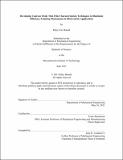| dc.contributor.advisor | Tonio Buonassisi. | en_US |
| dc.contributor.author | Brandt, Riley Eric | en_US |
| dc.contributor.other | Massachusetts Institute of Technology. Dept. of Mechanical Engineering. | en_US |
| dc.date.accessioned | 2012-01-11T20:18:28Z | |
| dc.date.available | 2012-01-11T20:18:28Z | |
| dc.date.copyright | 2011 | en_US |
| dc.date.issued | 2011 | en_US |
| dc.identifier.uri | http://hdl.handle.net/1721.1/68197 | |
| dc.description | Thesis (S.B.)--Massachusetts Institute of Technology, Dept. of Mechanical Engineering, 2011. | en_US |
| dc.description | This electronic version was submitted by the student author. The certified thesis is available in the Institute Archives and Special Collections. | en_US |
| dc.description | Cataloged from student submitted PDF version of thesis. | en_US |
| dc.description | Includes bibliographical references (p. 58-60). | en_US |
| dc.description.abstract | Future fossil fuel scarcity and environmental degradation have demonstrated the need for renewable, low-carbon sources of energy to power an increasingly industrialized world. Solar energy, with its extraordinary resource base, is one of the most feasible long-term options for satisfying energy demand with minimal environmental impact. However, solar photovoltaic panels remain expensive and employ materials whose resource bases cannot satisfy global, terawatt-level penetration. This necessitates the development of cheap, earth-abundant semiconductors for solar conversion such as cuprous oxide (Cu₂O). Poor solar energy conversion efficiency (<2%) has hindered the development of this material, yet it is not well understood what is preventing the material from approaching the idealized maximum efficiency of 20%. The present work aims to develop a thorough characterization method for Cu₂O thin films fabricated through a physical vapor deposition (PVD) process known as reactive direct-current magnetron sputtering. This both provides a platform for material analysis and an opportunity to adapt a typically high-throughput manufacturing method to make high quality thin films. Spectrophotometry, Hall Effect mobility measurement, and photoelectrochemical cell techniques are used in succession to determine the absorption and transport properties. The films are found to have a direct forbidden bandgap of 1.93 eV, with an absorption coefficient of greater than 10⁵ cm-¹ for photons carrying energy in excess of 2.6 eV. Majority carrier mobility is measured as 58.1 cm²/V·s, approaching the levels of monocrystalline oxidized films in literature. These high mobilities indicate that with carrier lifetime >10 nanoseconds, minority carrier diffusion length could easily exceed the film thickness. The photoelectrochemical minority carrier diffusion length measurement achieves success on gallium arsenide test samples, determining flat-band potential, quantum efficiency, and minority carrier diffusion length, paving the way for future Cu₂O measurement. Future work may apply this test procedure to fully characterize other materials, and eventually lead to solar cell fabrication. | en_US |
| dc.description.statementofresponsibility | by Riley Eric Brandt. | en_US |
| dc.format.extent | 60 p. | en_US |
| dc.language.iso | eng | en_US |
| dc.publisher | Massachusetts Institute of Technology | en_US |
| dc.rights | M.I.T. theses are protected by
copyright. They may be viewed from this source for any purpose, but
reproduction or distribution in any format is prohibited without written
permission. See provided URL for inquiries about permission. | en_US |
| dc.rights.uri | http://dspace.mit.edu/handle/1721.1/7582 | en_US |
| dc.subject | Mechanical Engineering. | en_US |
| dc.title | Developing cuprous oxide thin film characterization techniques to illuminate efficiency-limiting mechanisms in photovoltaic applications | en_US |
| dc.type | Thesis | en_US |
| dc.description.degree | S.B. | en_US |
| dc.contributor.department | Massachusetts Institute of Technology. Department of Mechanical Engineering | |
| dc.identifier.oclc | 770910506 | en_US |
